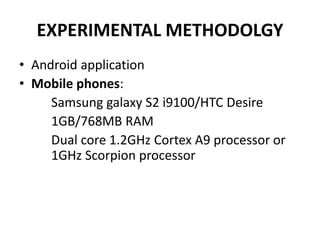Predicting bus arrival time based on participatory mobile phone sensing
- 1. Predicting Bus Arrival Time with Mobile Phone based Participatory Sensing SEMINAR BY : SREERAJ P RIT, KOTTAYAM
- 2. CONTENTS  INTRODUCTION  EXISTING SYSTEM  PROPOSED SYSTEM  SYSTEM DESIGN  IMPLEMENTATION AND EVALUATION  CONCLUSION  RELATED WORK  REFERENCES
- 3. INTRODUCTION • Bus arrival time is primary information to most city transport travelers. • The bus transport services reduce fuel consumption and hence must be encouraged. • Third party applications • Bus arrival time prediction based on crowd-participatory sensing.
- 4. • MOBILE PHONE BASED PARTICIPATORY SENSING – Participatory sensing is the concept of communities (or other groups of people) contributing sensory information to form a body of knowledge. – Mobile phones which has multiple sensors has made participatory sensing viable in large scale. – Participatory sensing can be used to retrieve information about the environment, weather, congestion etc.
- 5. EXISTING SYSTEM • Enquiry at Bus Depot. • Bus companies provide bus time tables on the Internet. • Installation of location tracking devices such as GPS in the bus.
- 6. DISADVANTAGES OF EXISTING SYSTEM • It usually requires the cooperation of the bus operating companies. • Companies don’t update the time table on a regular basis. • It requires installation of GPS which is very expensive. Also Power consumption of GPS is more.
- 7. PROPOSED SYSTEM • Crowd-participated bus arrival time prediction using cellular signals. • Independent of the bus companies • Bridges the gap between querying users and the sharing users.
- 8. • Querying Users Are the users who query about the arrival of the bus at a particular bus station. • Sharing Users Are the users who are currently present in the bus and are sharing the data using their smartphones in order to predict the bus arrival time.
- 10. • Implemented NOT in INDIA • Sharing users • Querying users • Backend server: collecting the instantly reported information from the sharing users, and intellectually processing such information so as to monitor the bus routes and predict the bus arrival time.
- 11. Pre-processing Cell Tower Data • Cell tower IDs are saved in a database using an initial experiment. • Top 3 Cell towers are taken into consideration as mobile phones connect to the tower which provides maximum signal strength. • Based on the Cell tower signals the bus route can be identified.
- 12. Bus Detection: Am I on the Bus? • Audio Detection Beep sound from the card reader Sensors are active all the time
- 13. • Accelerometer Readings – In Singapore the trains also have a system which makes a beep sound. – In order to avoid this accelerometer readings are taken with an interval of 20Hz.
- 15. Bus Classification • Cell tower sequence matching – Route in Database (1, 2, 4, 7, 8, 5, 9, 6) – Route from sharing user (7, 8, 5)
- 17. • Arrival time prediction When a user queries about the bus the backend server looks up the latest bus route status and calculates the arrival time at the particular bus stop. Historical data is also taken into consideration.
- 18. T=T2-t2+T3+TBS
- 20. EXPERIMENTAL METHODOLGY • Android application • Mobile phones: Samsung galaxy S2 i9100/HTC Desire 1GB/768MB RAM Dual core 1.2GHz Cortex A9 processor or 1GHz Scorpion processor
- 21. • Backend server Java running on the DELL Precision T3500 workstation 4GB memory and Intel Xeon W3540 processor.
- 22. COMPLEXITY At Backend server O(lk) O(lkN) l - uploaded cell tower sequence length k – cell tower set sequence length N – total candidate sequences in DB.
- 23. CONCLUSION • ADVANTAGES – Power Consumption is less compared to GPS – Real time availability of bus time table – More accurate as the number of sharing users increase – Independent of bus operating companies – Cost effective
- 24. RELATED WORK • Encourage more participants • Encourage specific passengers like the driver to install the mobile client
- 25. REFERENCES • G. Ananthanarayanan, M. Haridasan, I. Mohomed, D. Terry, and C. A. Thekkath, “Startrack: A framework for enabling track-based applications,” in Proc. ACM MobiSys, 2009, pp. 207–220. • P. Bahl and V. N. Padmanabhan, “RADAR: An in-building RF-based user location and tracking system,” in Proc. IEEE INFOCOM, 2000, pp. 775–784. • R. K. Balan, K. X. Nguyen, and L. Jiang, “Real-time trip informa- tion service for a large taxi fleet,” in Proc. ACM MobiSys, 2011, pp. 99–112. • Human localization using mobile phones,” in Proc. ACM MobiCom
- 26. • X. Bao and R. R. Choudhury, “MoVi: Mobile phone based video highlights via collaborative sensing,” in Proc. ACM MobiSys, San Francisco, CA, USA • J. Biagioni, T. Gerlich, T. Merrifield, and J. Eriksson, “Easytracker: Automatic transit tracking, mapping, and arrival time prediction using smartphones,” in Proc. ACM SenSys, 2011
- 27. Thank you..



























